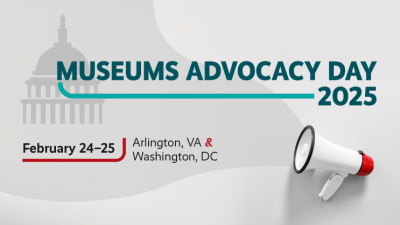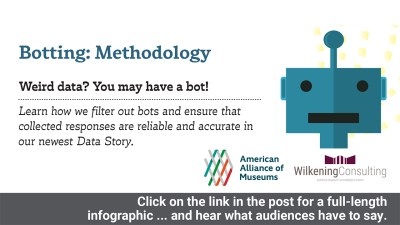Support Free COVID-19 Resources for the Field:
These resources have been taken out from behind the member paywall to make them free and accessible for all. The current crisis is taking a distressing financial toll on cultural organizations, and AAM is no different. In these challenging times, we ask that if you can, consider supporting our advocacy work and making extensive COVID-19 resources freely available for our field, by making a donation or becoming a member of AAM. Thank you for your much-needed support.
The American Alliance of Museums offers the following considerations in determining your museum’s face mask policy. The information shared here is based on the best available information as of publication in July 2021 and is not intended as legal, employment/human resources, or health and safety advice. Museums are encouraged to seek legal and other expert advice on their specific circumstances.
Given the rapidly evolving information related to COVID-19, please always consult the CDC for the latest federal guidance on face masks as well as guidance for those who are already fully vaccinated.
To maximize protection from the Delta (and other) variant(s) and prevent possibly spreading it to others, wear a mask indoors in public if you are in an area of substantial or high transmission.
Download a PDF version of this guidance here.
State/local laws, vaccination rates, and infection rates
As the COVID-19 vaccine rollout continues and more members of the public are vaccinated, several states and localities have withdrawn or amended mask mandates. Despite this, masks are still recommended in public for unvaccinated individuals. Before developing your museum’s mask policy, make sure you are aware of the laws and mandates in your state and local area. Museums may also want to consider state and local vaccination and infection rates, as these may vary widely by location.
CDC recommendations
With studies showing that a significant number of individuals with COVID-19 lack symptoms, the CDC emphasizes the importance of masks as a tool in stopping the spread of COVID-19, including for vaccinated people in some cases. The CDC does not recommend masks for children under the age of two due to the risk of suffocation, nor does it recommend masks for anyone who has trouble breathing or who is unable to remove a mask without assistance.
Expectations of museum-goers and museum staff
Even with recent updates to public health guidance and mask mandates, data shows that members of the public strongly prefer that museums continue to require masks in indoor museum settings.
Research from IMPACTS Experience documents that although museum-goers are more likely than the general public to be vaccinated, masks are still an important determinant in making all visitors feel safe.
In the latest Data Story from Wilkening Consulting and AAM drawn from national survey data, two-thirds of people surveyed, and three-fourths of those who self-identified as frequent museum-goers, stated that they would prefer some requirement for masks in indoor museum settings. Parents of young children—who are not yet eligible to be vaccinated—expressed that they would feel more comfortable taking their children to an indoor museum setting with mask requirements than a setting without mask mandates, with 43% sharing that they would only take their children to settings that require masks.
With regard to the attitudes of museum staff, in response to a survey conducted by AAM in April 2021, frontline museum staff shared that health and safety upon returning to work was their third largest concern, and a prioritization of health and safety in the workplace is one of the actions employers could take that make staff feel safe, valued, and supported. Wearing masks can help ensure that museum spaces are welcoming to everyone—staff and visitors.
Coordination with the museum community
As with other health and safety guidelines related to COVID-19, museum leadership should consider connecting with other museum leaders in their local community to discuss a coordinated or unified approach to mask policies. Consistency across institutions can help with public expectations and trust. For a list of other AAM member institutions in your area, see AAM’s member museum directory.
Legality and the Americans with Disabilities Act
For employees
Generally, an employer/business can institute safety policies or workplace rules such as requiring its employees to wear a face mask. Be mindful of abiding by the Americans with Disabilities Act (ADA) in creating and enforcing such policies, as individuals with a chronic disease that makes breathing difficult may be unable to safely wear masks or face coverings. The U.S. Equal Employment Opportunity Commission (EEOC) notes in Pandemic Preparedness in the Workplace and the Americans with Disabilities Act that “an employer may require employees to wear personal protective equipment during a pandemic. However, where an employee with a disability needs a related reasonable accommodation under the ADA, the employer should provide these, absent undue hardship.” The Society for Human Resource Management (SHRM) offers updated considerations for businesses on when employers should lift mask mandates.
For visitors
Depending on your museum’s structure and governance type (college/university, state, federal, etc.), your face mask policy may be determined by another authority, such as a parent organization or local government. Private businesses—including many museums—may still require customers/visitors to wear face masks. If your state or local government has removed or reduced mask mandates in public but you wish to continue requiring masks in your museum, it is recommended that you seek legal guidance around the enforcement of your policy. As with policies for employees, be mindful of ADA implications. Consider using language in your policy that reflects the CDC recommendations for who should and who should not wear a mask (e.g., “This requirement does not apply to fully vaccinated individuals, children under the age of two, or individuals who are unable to wear a face covering due to a medical condition”). The HR Executive, an online publication, and the Southeast ADA Center and Burton Blatt Institute (BBI) at Syracuse University provide additional information on ADA considerations for businesses requiring face masks for customers/visitors.
Training on proper use of masks
Whether mandating or recommending face coverings, be sure to offer your employees training on how to properly wear and clean masks (see CDC guidance).
Accessibility
Transparent face coverings can be helpful for individuals who identify as Deaf or hard-of-hearing and rely on lipreading. If your museum requires face masks for employees, keep this in mind for staff members who interact regularly with members of the public and if you have individuals who identify as Deaf or hard-of-hearing on your team.
Equity and racial implications
In thinking about your policies and how you will enforce them, it is important to consider the history and present-day realities of racial profiling. People of color, particularly Black men, risk being profiled, harassed, or assaulted because of facial coverings. It is recommended that museum staff receive anti-bias training and develop awareness and understanding of ways that policies and laws designed to protect may endanger communities of color. It is essential to have a heightened awareness of increased levels of anxiety for both employees and visitors of color while making considerations around the use of masks. Safety comes first, but unfortunately for Brown and Black communities, mask wearing often makes it more difficult to remain safe.
Availability of masks
Can your museum supply masks to all staff and visitors? If you are requiring face coverings as a condition of entry into the museum, providing free masks may be helpful to those who do not have, cannot afford, and/or did not bring their own. Some museums are also selling branded masks onsite and online (for example, see the Cincinnati Zoo’s animal-themed masks and the Detroit Institute of Arts’ fine art masks). If you will not have masks available to sell or give away, it is helpful to prepare people in advance for their visit by clearly communicating on your website, phone recordings, and/or social media channels that visitors should bring their own face covering.
Tensions over masks, enforcement of policies, and employee training
It is important to be aware of the polarization around and politicization of the wearing of face masks and other health and safety measures. Confrontations and violence over mask-wearing have been reported in the news in the past year.
If masks are required (either by your museum or by law in your area), consider how the policy will be enforced and who will enforce it. Make your policy very clear on your website and on signage outside of the museum to reduce the potential of face-to-face conflicts. Train employees on how to handle violations and de-escalate tension, and be sure that anyone being asked to enforce policies is properly trained and has authority (e.g., security personnel, senior leadership) to handle policy violations. Concerns around potentially putting employees in harm’s way have led some businesses to decide—when there is no local or state mandate in place—to encourage but not require face coverings or to be cautious in enforcing requirements if it seems that doing so could lead to threats or violence.
The Crisis Prevention Institute (CPI), the worldwide leader in evidence-based de-escalation and crisis prevention training, has shared tips and tools to address the urgent public need to anticipate and effectively address situations related to COVID-19 before they escalate. See their de-escalation tips in light of coronavirus anxiety and de-escalation trainings for the workplace.
Communication
Communicate proactively with both staff and the public about COVID-19-related plans and protocols. Provide as much information as you can about your museum’s health and safety guidelines, recommendations, and/or requirements on your website, telephone recordings, social media channels, etc. This will help visitors prepare for their visit, understand the measures you are taking to protect them, and reduce the chance of confusion or even confrontation onsite. Also, provide signage onsite that communicates your policies, using language that is clear and simple. The following examples are shared for reference:
- The National Cowboy Museum’s signage about how to have a safe and enjoyable museum experience, including the recommendation that visitors wear masks
- Sign at the Museum of Fine Arts, Houston about face mask requirements
- Greyhound’s signage about required face coverings
- Virginia Living Museum https://thevlm.org/visit/about-us/museum-status/
- Holocaust Museum Houston https://hmh.org/visit/
- Stay up to date on what other museums are doing in AAM’s online community, Museum Junction. There is a thread related to masks: “Mask policies after CDC lifting for vaccinated persons.”
- Children’s Museum of Indianapolis https://www.childrensmuseum.org/visit/health-and-safety-procedures
Feedback on this resource? Additional examples to share? Contact content@aam-us.org.
Last updated July 2021









Comments